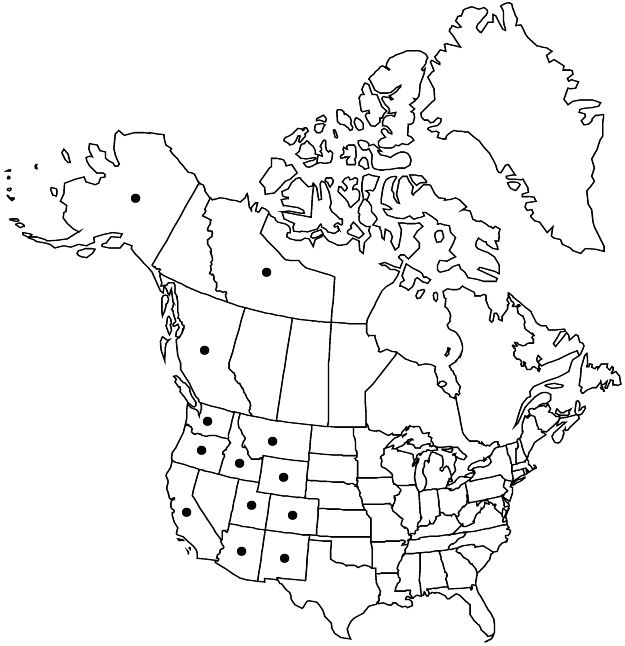Rosa nutkana
Abh. Königl. Böhm. Ges. Wiss., ser. 5, 6: 563. 1851.
Shrubs, loosely clustered or forming dense thickets. Stems erect or spreading, stout or lax, 4–25 (–40) dm, densely or openly branched; bark dull reddish-brown, older wood with gray exfoliate, glabrous; infrastipular prickles 0–2, erect, curved, or hooked, often flattened, stout, subulate, sometimes deltoid, (2–) 3–15 (–20) × 2–10 (–15) mm, base glabrous, internodal prickles usually sparse or absent, smaller, mixed with aciculi, sometimes absent. Leaves (3–) 5–12 (–17) cm; stipules 12–20 (–28) × 3–5 (–10) mm, auricles flared, 3–6 (–10) mm, margins sinuate or shallowly serrate, sparsely to ± densely stipitate-glandular, surfaces glabrous, rarely pubescent, eglandular; petiole and rachis with pricklets absent or sparse, glabrous or pubescent, sessile or stipitate-glandular; leaflets 5–7 (–9), terminal: petiolule (3–) 5–17 mm, blade ovate, elliptic, or suborbiculate, rarely cordate or oblong, (14–) 20–55 (–63) × (6–) 10–30 (–40) mm, firm, base cuneate to obtuse, margins 1–2+-serrate, teeth 8–20 per side, often broad-based 2–4 mm, acute to obtuse, eglandular or gland-tipped, apex acute or obtuse, rarely acuminate, abaxial surfaces green, glabrous or sparsely pubescent, eglandular or sessile-glandular, adaxial green, dull, glabrous. Inflorescences corymbs, 1–3 (–9) -flowered. Pedicels erect or recurved, slender to stout, 10–20 (–33) mm, glabrous, eglandular or sparsely stipitate-glandular; bracts 1 or 2 (or 3), ovate, 13–20 × 4–9 mm, margins entire, surfaces glabrous, glandular or eglandular. Flowers (3.5–) 4.5–7 (–8.5) cm diam.; hypanthium globose to subglobose or ovoid, 4–10 × 5–8.5 mm, glabrous, eglandular, sometimes setose-glandular, neck (0–) 0.5–1.5 × 3–6 mm; sepals spreading, lanceolate, 14–25 (–35) × (2–) 3–4 mm, tip 5–10 (–20) × 1–3 mm, margins entire, abaxial surfaces glabrous or slightly hairy, stipitate-glandular and sessile-glandular or eglandular; petals single, pink to deep rose, (15–) 20–32 × (15–) 20–32 mm; stamens 100; carpels 28–58, styles exsert 1 mm beyond stylar orifice (2–2.5 mm diam.) of hypanthial disc (5 mm diam.). Hips red, orange-red, or purplish red, globose, depressed-globose, ovoid, oblong, or urceolate, (8–) 10–20 (–24) × 10–20 (+) mm, fleshy, glabrous, sometimes setose, eglandular or glandular, neck (0–) 1–2 × (4–) 5–8 mm; sepals persistent, erect, sometimes spreading. Achenes basiparietal, (1–) 16–40, tan to dark tan, 4–6 × 2–4 mm.
Distribution

B.C., Alaska, Ariz., Calif., Colo., Idaho, Mont., N.Mex., Oreg., Utah, Wash., Wyo.
Discussion
Subspecies 3 (3 in the flora).
Rosa nutkana is a widespread, polymorphic, hexaploid species that occurs from coastal Alaska to northern California, and eastward in the Rocky Mountains from Montana to New Mexico (W. H. Lewis and B. Ertter 2007). Flowers and hips are usually solitary and significantly larger than in most sympatric species, and sepal tips are usually conspicuously prolonged and expanded. Eglandular and stipitate-glandular or setose hips can occur in the same population.
A presumed hybrid between subsp. nutkana (6x) and Rosa rugosa (2x) has been reported from Washington state. In Colorado, at the southeasternmost range of R. nutkana, a putative hybrid between subsp. melina and R. acicularis subsp. sayi has been recognized as R. ×engelmannii S. Watson. It is based on such intermediate characteristics as few infrastipular prickles with interspersed aciculi on distal stems and fertile branches, sparsely stipitate-glandular abaxial sepal surfaces, petioles and rachises with few pricklets, and blade margins 1- or multi-serrate.
Among the Lillooet and Thompson tribes of southwestern British Columbia, Rosa nutkana is considered of high value for use in traditional medicine (N. J. Turner 1988). They do not distinguish R. acicularis and R. woodsii from R. nutkana and use them similarly; R. gymnocarpa is distinct in name and use. Root extracts of R. nutkana, probably subsp. nutkana, were found to be active against an enteric coronavirus in antiviral screening (A. R. McCutcheon et al. 1995).
Selected References
None.
Key
| 1 | Stems 4–10(–15) dm, internodes 2–2.5 cm; prickles (fertile branches) usually curved or hooked, rarely erect, rarely absent; sepal abaxial surfaces sessile- or stipitate-glandular; 2500–3800 m, s Rocky Mountains to Wasatch Mountains. | Rosa nutkana subsp. melina |
| 1 | Stems (6–)10–30(–40) dm, internodes 2–6.5 cm; prickles (fertile branches) erect, rarely curved, sometimes absent; sepal abaxial surfaces stipitate-glandular or eglandular; 0–2300 m, coast to n Rocky Mountains | > 2 |
| 2 | Shrubs densely branched; internodes 2–4 cm; infrastipular prickles rarely absent; terminal leaflets abaxially glandular or eglandular, margins usually 2+-serrate, teeth gland-tipped; Alaska to n California w of Cascade Mountains. | Rosa nutkana subsp. nutkana |
| 2 | Shrubs openly branched; internodes 5–6.5 cm; infrastipular prickles usually absent; terminal leaflets abaxially usually eglandular, margins 1-serrate, teeth eglandular; e Cascade Mountains to n Rocky Mountains. | Rosa nutkana subsp. macdougalii |
"dm" is not declared as a valid unit of measurement for this property."dm" is not declared as a valid unit of measurement for this property."dm" is not declared as a valid unit of measurement for this property.